The Village at the Edge of the Anthropocene
In Newtok, Alaska, villagers look to innovative design to save their community
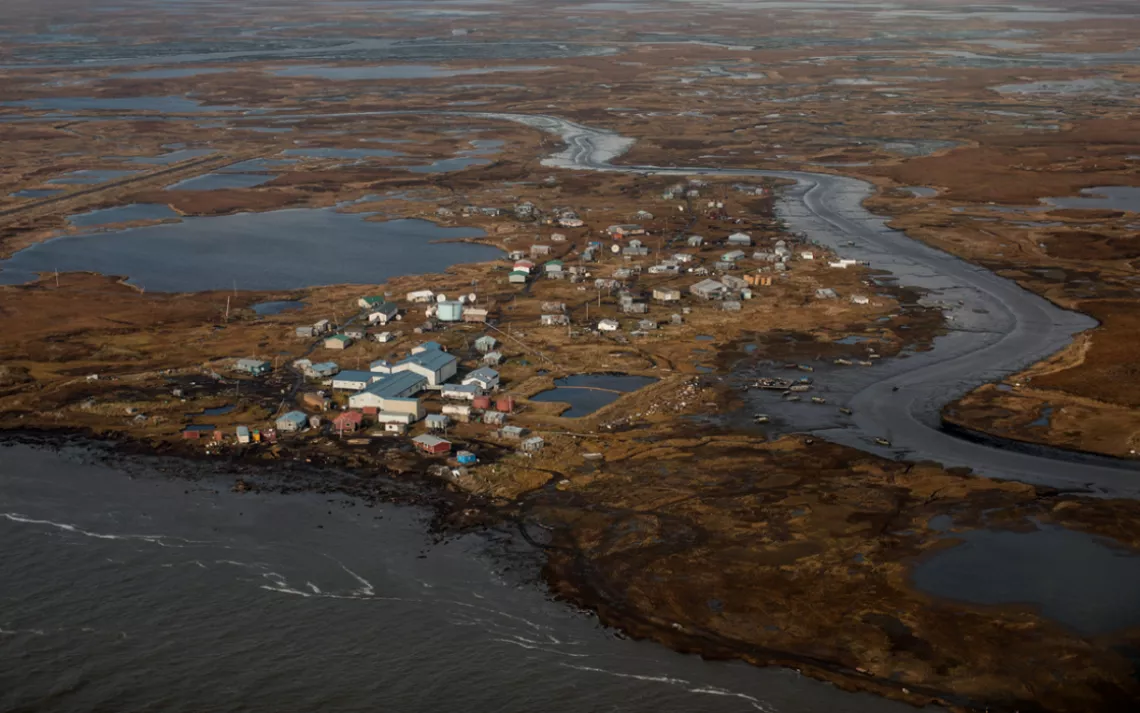
Warming temperatures from climate change are making the permafrost and tundra surrounding Newtok, Alaska, increasingly unstable. | Photos by Ash Adams
IN SPRING 2019, Charlene Carl started packing up the belongings in two family homes in Newtok, Alaska, before they were both razed. Her feelings about this were complicated.
As Carl wrapped protective layers of newspaper around her late grandmother's teacups and kettles—which her uncle had kept for decades—she tried to imagine her grandmother's voice again. Then one August evening, she gathered the last items from the red wood-framed house in which she lived with her partner, parents, sister, nieces, and nephews. While she collected shoes, a small television, some electrical wiring, the yarn with which she crocheted, and various papers and books, she queued up pop songs on her iPod and turned up the volume—Kelly Clarkson's "Stronger" and Alessia Cara's "Scars to Your Beautiful." Intermittently, she cried.
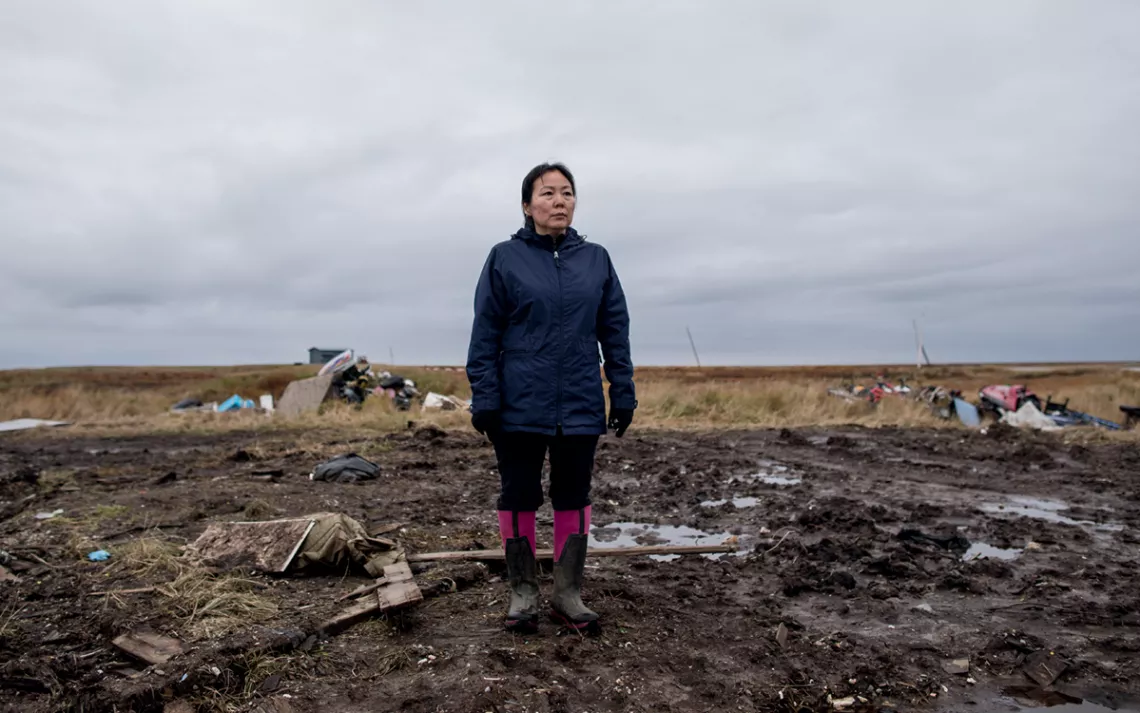
Charlene Carl where her home used to be.
The Carls weren't the only family that had to go. For decades, Newtok—a village of about 375 people, nearly all of whom belong to the Indigenous Yupik community of Southwest Alaska—has been trying to relocate to escape the catastrophic erosion that has progressively ripped apart the ground. The crisis has become far more menacing and urgent as climate change has boosted winter temperatures across the region, thawing the permafrost that underlies the soil and destabilizing the village.
For years, it wasn't clear what the outcome would be for Newtok. It seemed like the next storm could force the whole community into crisis. Every fall, winds were so fierce that they shook people's houses—even rocking the heavy edifice of the school where Carl taught back and forth on its foundation. One of the Carls' nearest neighbors, Katie Ayuluk—a 25-year-old who had been raising two small daughters in a house close to the erosion's edge but had moved into the local school after losing the house—suffered a recurring nightmare: "Our land fell in water, and the only place we could go to was our boats." Last year, Andrew John, the Newtok tribal administrator, set up wooden stakes in front of some houses to measure and track the distance to the erosion line, near the Ninglick River; on one gusty morning, 20 feet of tundra toppled in front of a man's house. In autumn 2018, a storm ripped the roof off the shed where George Carl, Charlene's father, kept his fishing nets.
Like many other villagers, Charlene Carl looked forward to leaving. She yearned for a place of greater safety. Her father, the president of the Newtok Village Council, had spent more than a decade helping with the relocation process. Her partner, Romy Cadiente—originally from Hawaii—had settled here with her 13 years ago, eventually taking a leadership role in coordinating the construction at a new village site nine miles away.
The new village was a place called Mertarvik, built on land with a solid foundation of bedrock and sporting important design features that would hopefully keep the community from facing this kind of crisis in the future. If all went as planned, the new village would let the people of Newtok stay together and would provide for 21st-century needs (like internet and cellphone service) while keeping alive the Yupik traditions of hunting, fishing, and subsisting off the tundra. In the process, Newtok could be at the vanguard of communities that are innovating climate-adaptive architecture and designs. But much depended on the new infrastructure, which would have to be hardy enough to withstand the ferocious weather of the tundra and the upheaval brought by a warming atmosphere.
In 2019, when 13 new houses went up at Mertarvik (it will take the name Newtok when all residents are relocated) and eight houses in Newtok came down, the first third of the community finally began the move.
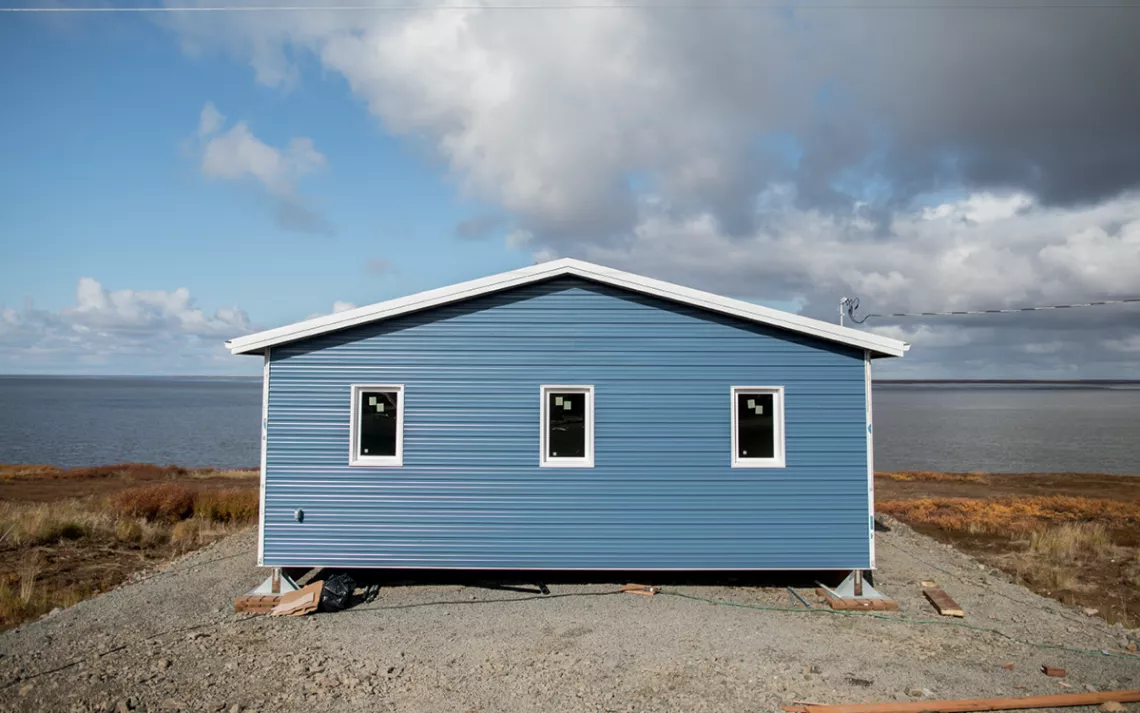
One of the new homes in Mertarvik
Carl wanted to be happy. But she had grown up in Newtok and still felt a deep attachment. For several weeks after their house was gone, Cadiente and Carl used Carl's classroom as a makeshift home, sleeping on gym mats spread out across the floor and eating meals from a microwave they had set up behind her desk. Cadiente worked seven days a week to organize the move to the new site across the river. He spoke with dogged optimism about the construction of the past season, though some days he appeared overwhelmed by the magnitude of re-creating and moving an entire village. Sometimes, Carl said, she would catch herself nearly making the wrong turn on the wooden boardwalks that crisscrossed the mud and grass. "Just for a moment, and then I'd remember, 'Oh, no, we don't have a house right there anymore.'" One night, she donned her neoprene boots to go outside and show a pair of journalists the bare, soggy ground where the house had been. She reached her arms out as if to touch the imaginary wooden walls.
Days later, contractors switched the power on at Mertarvik, and when the weather cleared, everyone in Newtok could see the distant lights glinting across the water.
"I know people have prayed for their new homes," Carl said. "Our new homes, we'll make memories and keep safe from the storm."
INDIGENOUS YUPIK CULTURE is rooted deeply in this moody, stormy landscape, and the people can't easily be severed from the place.
"What we were really scared about was dislocation, because these people were here for generations," Cadiente said, the pitch of his voice rising in urgency. "This Mother Nature is their medicine, is their guidance. And if you lose any of that stuff, you essentially kill these people that have been here for thousands of years."
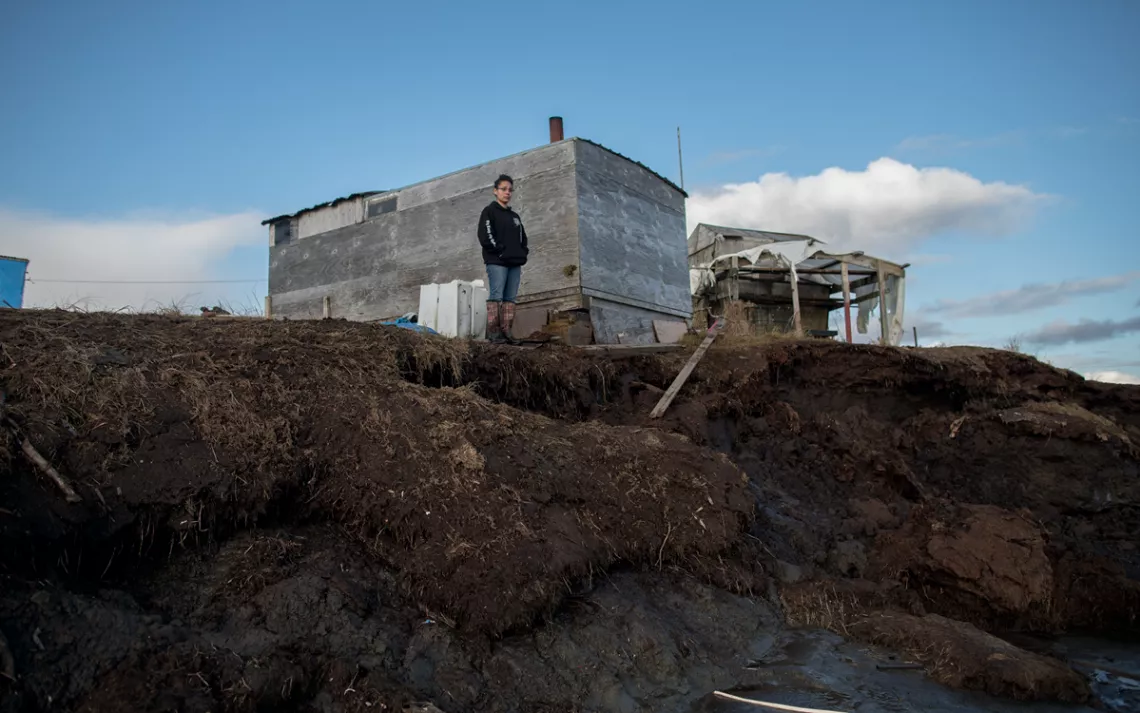
Katie Ayuluk stands at the coastline near where her home used to be.
Newtok sits in a region known as the Yukon-Kuskokwim (or Y-K) Delta, which is dominated by two muscular rivers: the Kuskokwim, the longest free-flowing river in the United States, and the Yukon, the third-longest river in North America. Cross over the landscape in a propeller plane (one of the few means in and out of the roadless region) and one can see river channels twisting like dense cords through a green fabric of grass, willows, and dwarf shrubs. Squint from this vantage point and it can seem like the water is solid and the landscape fluid. But underlying it is frozen ground—permafrost. In the frigid winters, the surface soil and rivers also freeze. Ice holds everything together, but parts of this place are inherently dynamic and erodible. As climate change increases temperatures all over Alaska, the foundation of this place—the very ground—is rapidly coming apart.
About 26,000 people live in the Y-K Delta, with 6,000 of them in the region's only city, Bethel—a small airline hub. The rest are clustered in tiny, rural settlements like Newtok. Over 90 percent are Alaska Native, mostly Yupik, and can trace their origins in the region back at least two millennia. Reverence for the landscape and gratitude for the sustenance it offers are woven into Yupik traditions. When someone successfully hunts their first seal, they often give the meat away to an elder, and the family sometimes organizes a celebration. According to one study, Southwest Alaska meets all its protein needs through fishing and hunting; most residents eat locally harvested moose, king salmon, and geese.
Newtok has one of the most serious erosion problems in Alaska. But troubles are creeping up around the state. Some communities have opted for more temporary and ad hoc means of coping. For instance, the village of Napakiak, 90 miles east of Newtok, regularly jacks up its houses, lifts them onto a steel trailer, and carts them back from the rapidly eroding edge of the Kuskokwim River (a temporary fix that cannot save big buildings such as schools and fire stations and has never been attempted in Newtok, which has no equipment suitable for the task). Quinhagak, on the coast due south of Napakiak, installed thermosiphons designed to pull heat from the ground and keep the tundra frozen. The technology didn't work: The soil was still too warm. As climate change worsens, these kinds of efforts are not enough. More communities will have to move.
A couple of generations ago, the relocation of a place like Newtok might have been easier. Until as recently as the 1950s and '60s, the architecture of the region was entirely local, nimble, functional, and well suited to this landscape of ice, water, and tundra. People lived in earthen dwellings (also known as sod houses) lined with driftwood and woven-grass mats. According to those who are old enough to remember them, sod houses were comfortable and efficient, kept warm with seal-oil lamps and wood-burning stoves. They were better and warmer than the houses people live in now, one Newtok elder told me. With such simple dwellings, it was far easier for people to pick up and leave when necessary.
George Carl spent part of his childhood in a sod house in a village called Kealavik, along a river of the same name, before moving to a driftwood log house in Newtok. According to some accounts, people began settling around Newtok as early as the 1940s, after Kealavik experienced flooding. Then in the mid-1950s, the Bureau of Indian Affairs began operating a school in Newtok, a few miles from Kealavik. The location of Newtok was chosen haphazardly—it was the farthest point upriver that a barge was willing to travel. But the law stipulated that Alaskan children must receive a formal education, and families didn't want their young kids shipped off to distant boarding schools. So they set up homes nearby.
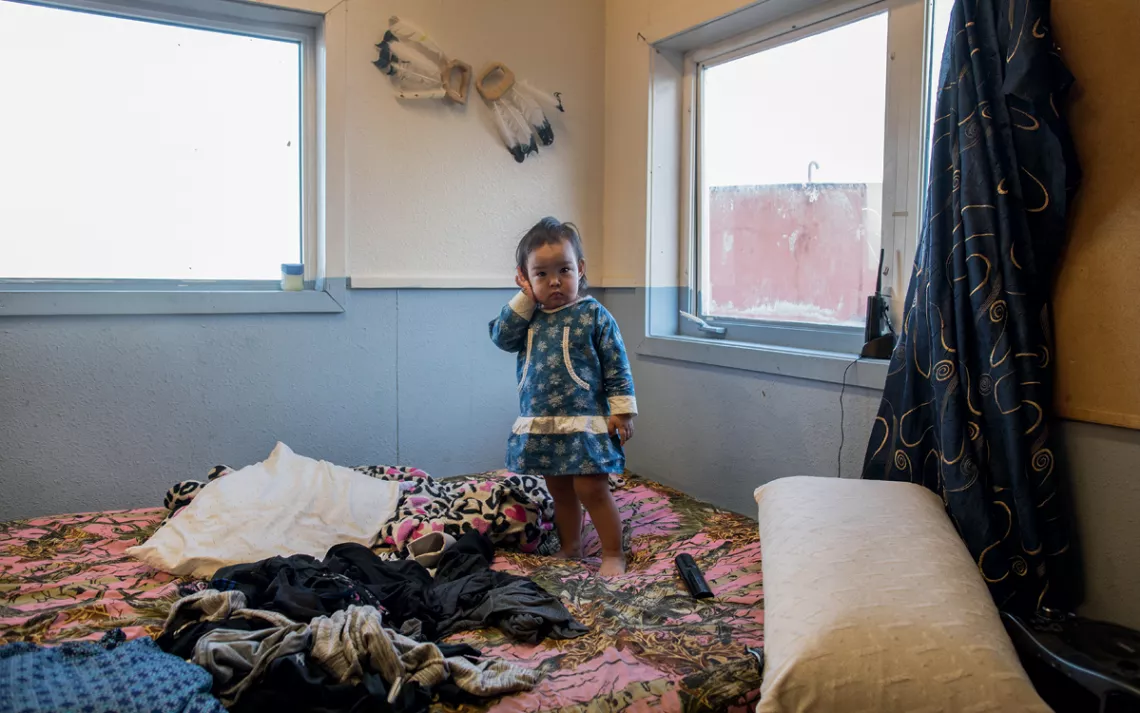
Katie Ayuluk's daughter at the school where the family has been living.
The tundra at Newtok was drier and higher then, elders recall—grassy and full of hillocks—and many people say that the storms were milder and less frequent. In the 1960s, locals started building rectangular wood-framed houses and a tiny Catholic church of the same design. This was an imported architecture incorporating nonlocal materials. The structures themselves—drafty and thin-walled—were never really suited to the severe winters. Their inhabitants had to rely more heavily on oil and diesel fuel to make them livable.
In response to increasing concerns about land erosion, in 1983, Newtok residents hired engineering consultants, with funding from the state of Alaska, to document the problem. The engineers found that the Ninglick River was pummeling, thawing, and ripping apart the icy soil along its banks. Even at that time, it was clear that the erosion would eventually threaten the village's existence.
"Relocating Newtok would likely be less expensive than trying to hold back the Ninglick River," the engineers wrote.
In the 1990s, the Newtok council began planning to relocate and chose Mertarvik because of its proximity and stability. But the relocation process stalled several times because of funding constraints and political hurdles. For instance, although Mertarvik was a traditional stopover for community members on camping trips (its name in Yupik means "getting water from the spring"), the land was owned by the federal government, and Congress didn't approve a land transfer until 2003. Thereafter, the community struggled with a number of state and federal policies that prohibited funding to build on a site with no permanent residents.
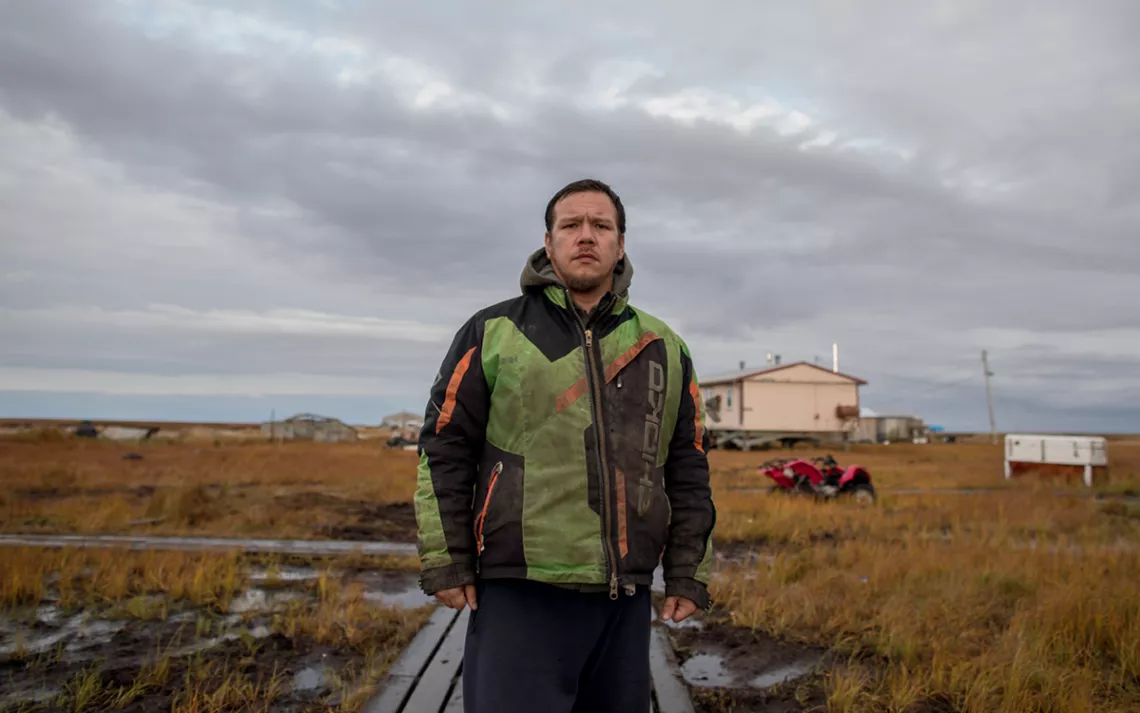
Andrew John, Newtok's tribal administrator
Newtok became ever more vulnerable to the impacts of erosion. The Ninglick River ate between 36 and 83 feet of the village's shoreline every year. In September 2005, a major storm
swamped Newtok, turning it into an island.
Meanwhile, the village's design has become impractical for contemporary needs. Newtok's electricity still comes from a diesel plant that dates back to about 1980—a sizable generator that groans and whirs inside a weathered wooden shack—and every month, families spend about $500 on oil to power small heating stoves and roughly $200 on electricity. A couple of satellite dishes provide a slow internet connection and spotty cellphone service. The village pumps its water from a nearby pond; the water is treated and injected with chlorine before being pumped into a centralized tank. But the houses aren't plumbed. Newtok has never had flush toilets, so every household heaves its sewage out in buckets and dumps it into the river—a major health hazard.
There are no feasible ways to return to sod-house living (and those traditional dwellings probably wouldn't be stable on top of thawing permafrost). A Yupik village that will last the rest of the 21st century—in a time of warming and thawing—will have to be different from anything built in the past. This will require some trial and error, with more than a few mistakes.
THE NEWTOK COMMUNITY first attempted to build at Mertarvik in 2006. At the time, the site had no modern structures. A crew of local builders and carpenters assembled a small boat ramp and unloaded three prefab housing kits, purchased with funding from the Bureau of Indian Affairs. Over multiple seasons, they worked in 12-hour shifts, surviving on instant noodles. With nothing but a few power tools and, as one builder put it, "man power," they had three stick-frame houses finished by 2008. But the building materials suffered water damage, and over the next several years, the houses became moldy and uninhabitable.
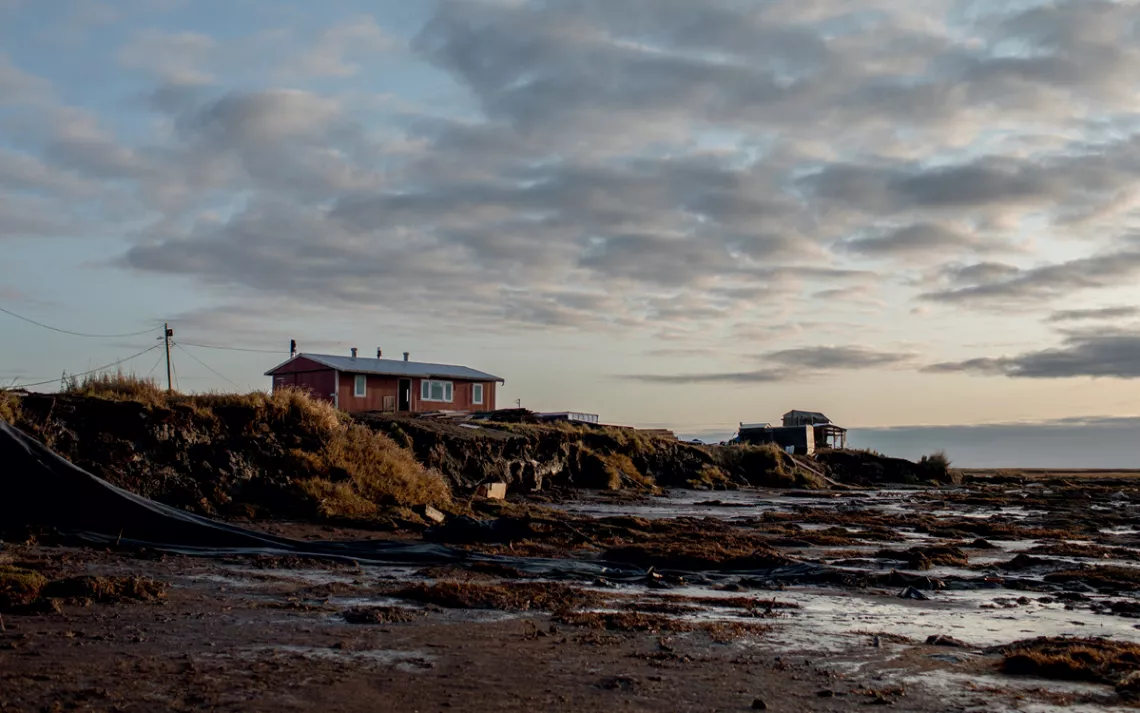
The coastline of Newtok, Alaska. Because of erosion, it has crept steadily in toward the homes in the village.
The story of Newtok could have ended there, with a failed construction experiment followed by the thawing ground unraveling and the community scattering. Building a modern village in rural Alaska is costly and onerous. Rural communities are socially and economically isolated from the politicians and big funders who might help them. The whole thing seemed to be an unlikely endeavor. But over the years, the people of Newtok had gathered allies among state and federal bureaucrats and prominent Alaskan organizations; in 2006, those allies had formed an unusually tight collaboration called the Newtok Planning Group to try to help the village.
In 2009, with the assistance of this group, Newtok applied for help from the Department of Defense through a program called Innovative Readiness Training, in which military personnel practice skills similar to those required when building a base in hostile territory while "providing incidental benefit to communities"—a kind of service learning for soldiers. In 2009 and 2010, military personnel traveled to Mertarvik to build roads and blast a rock quarry into the bluff. Two years later, builders from Newtok returned to put up three new homes of a somewhat more energy efficient design. There was no school at the new site yet, no health clinic, no store, and nothing to support families with young children. A group of elders moved into the houses seasonally, camping out each summer in an empty place without any electricity, telecommunications, or infrastructure. But the ground settled beneath these houses, and the foundations sagged.
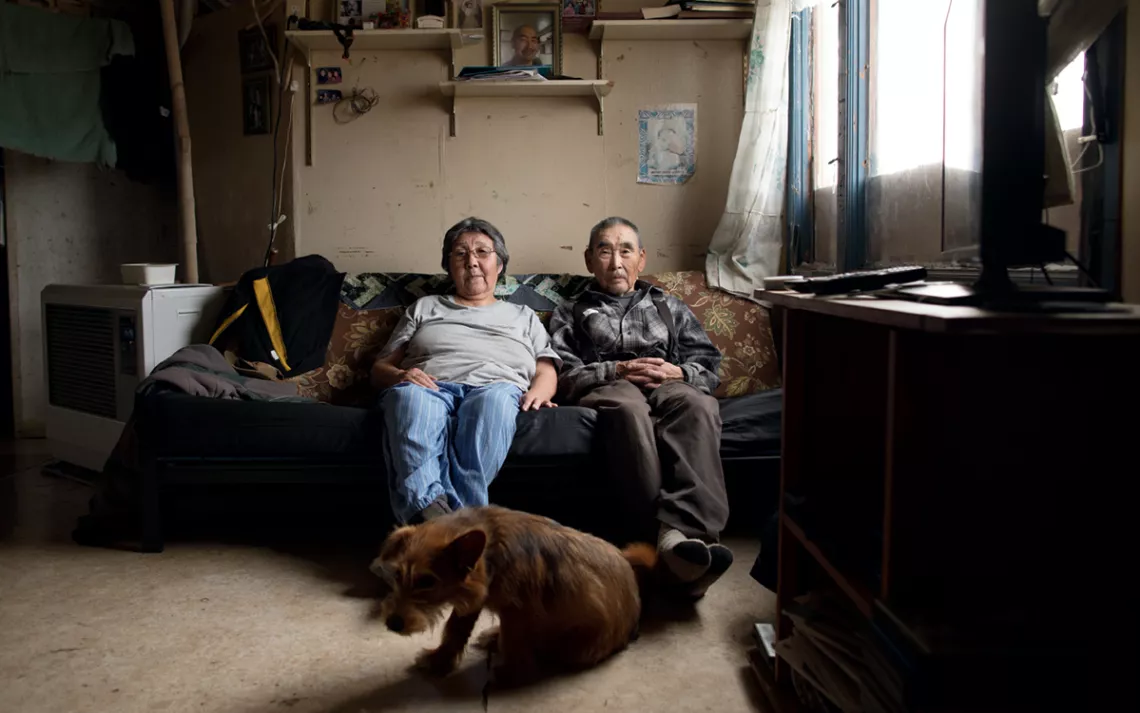
Mary and Mark George in their home in Newtok, Alaska
Any village that was going to survive in a volatile landscape in a time of climate change would need better buildings. Newtok had also been working with the Fairbanks-based Cold Climate Housing Research Center, founded by an Alaskan builder named Jack Hébert. Hébert and his colleagues at Cold Climate were among the first people in the world to design houses and infrastructure specifically to handle both the uncertainties of climate change and the harshness of northern latitudes. In 2009, Cold Climate delivered a preliminary design for an evacuation center for Newtok, a project later overseen by a commercial contractor.
Cold Climate develops contemporary homes for rural settings based on cultural needs. Hébert doesn't claim that he can save the world with a smart home powered by robots. Rather, the organization's goal is to build things that can function well in their surroundings, even as those surroundings get warmer and soggier. One of Cold Climate's first prototypes—in Anaktuvuk Pass in the Arctic—was based on sod-house principles, coated in a thick layer of insulation, partially encased in soil berms, and equipped with solar panels. (Locals there nicknamed it "the Flintstone house.") Cold Climate has also been developing house foundations that can adjust to the thawing, shifting, settling earth—on metal frames that look like a cross between a bridge and a box spring, designed so that homeowners can relevel crooked houses on their own.
A tundra home in a time of climate change also needs an element of self-reliance, including, potentially, the ability to treat its own water and sewage. Conventional, Lower 48 centralized water systems have always been difficult in northern latitudes. Pipes can't run through permafrost. Any time the ground shifts, the whole system can break and leak.
"There have been two choices for Alaska," said Aaron Cooke, a Cold Climate architect. "You get a multimillion-dollar [water and sewer] system that no one, once it's built, can afford to maintain. Or you get a bucket to poop in. . . . What is the holy grail? Everybody's looking for something in between."
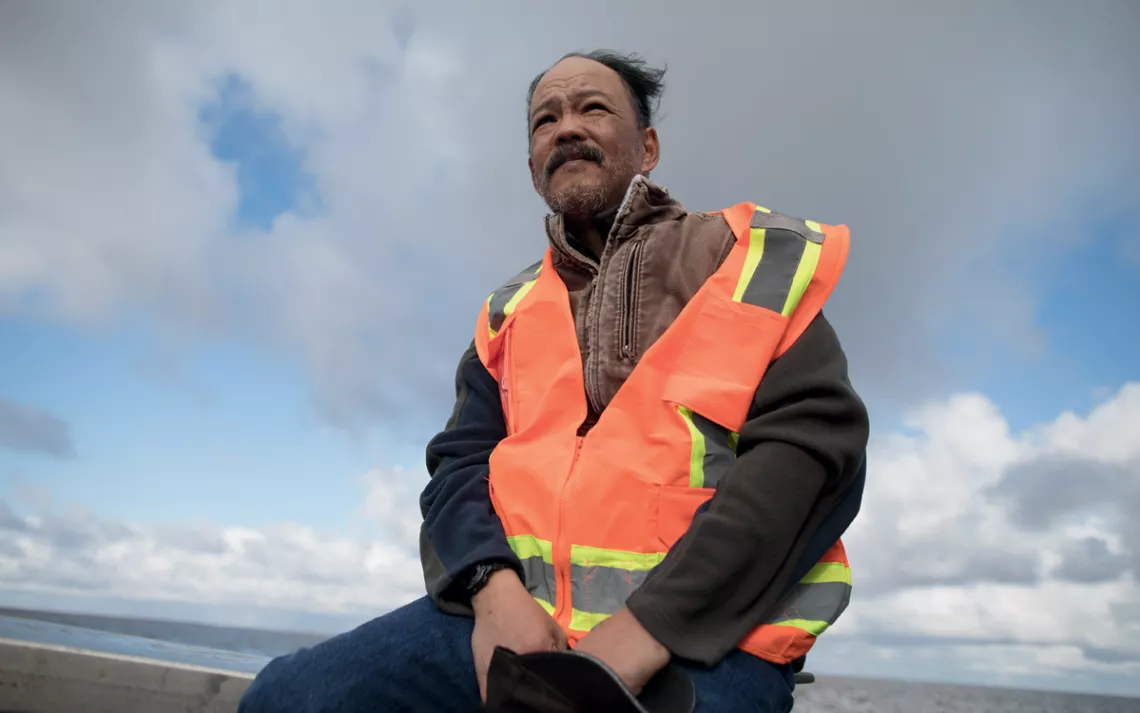
Romy Cadiente rides on a boat back to Newtok.
Water conservationists around the world have long advocated for waterless toilets—which either dry or compost human waste instead of flushing it—as an answer to drought and water scarcity. In Alaska, such systems might solve the bucket problem. Cold Climate had been experimenting with Arctic-friendly waste-treatment systems, sanitized with bacteria that wouldn't die during the winter freeze. In Kivalina, on the shores of the Arctic Ocean, Cold Climate and the Alaska Native Tribal Health Consortium (ANTHC), a nonprofit Tribal health organization that runs public health programs all over Alaska, designed a simple separating toilet that dries human waste into an inert thing that anyone can safely discard with the household trash. They paired it with a gravity-fed water-treatment tank small enough that any family could remove it from their house and take it on a fishing trip. This system would also serve a new set of houses in Mertarvik.
In 2016, Cold Climate built a new prototype house in Mertarvik, again constructed with village labor and so efficiently insulated that it would use only about 20 percent of the heating fuel required by an average rural Alaskan home. And this house, unlike its predecessors, neither sank nor grew mold. Two years later, the village hired the organization to design and oversee the construction of 13 more houses. After piecing together a series of grants, the community enlisted ANTHC to orchestrate a massive construction effort involving multiple state, federal, and regional agencies and several contractors.
The work at Mertarvik proceeded in great earnest in spring and summer 2019. This time, the labor wasn't mere man power but a team of outside contractors and builders with heavy machinery. The Department of Defense returned to help; in the summer, dozens of men and women in combat fatigues arrived at Mertarvik in Black Hawk helicopters and spent every day putting up houses and buildings and laying gravel roads. By the end of the season, Mertarvik was not just a hodgepodge construction site but a real place with roads and houses, power and light.
On a rare sunny afternoon in late September, Cadiente escorted a boatful of journalists to Mertarvik to document the story of the move. The boat roared past an area of tidal mudflats and followed the shoreline. Gulls sat atop the choppy water, so fat they looked like sailboats. An arctic fox perched on the side of a muddy bluff, watching.
Then Mertarvik came into focus—blue and hazy, then sunlit and solid. Cadiente pointed to what had been built and what was still to come. Twenty houses were already lined up across the bluff, in bright shades of garnet, sky-blue, and sage-green. A teal building, the evacuation center, stood beside them—part temporary school, part community center, part emergency gathering space. Above this were a landfill and a silver-gray rock quarry; beside them, a wide gravel runway. To the north, there would eventually be an airport, with construction to begin the next year. On the hill, someday, there might be wind turbines. Beyond that, the unbroken tundra.
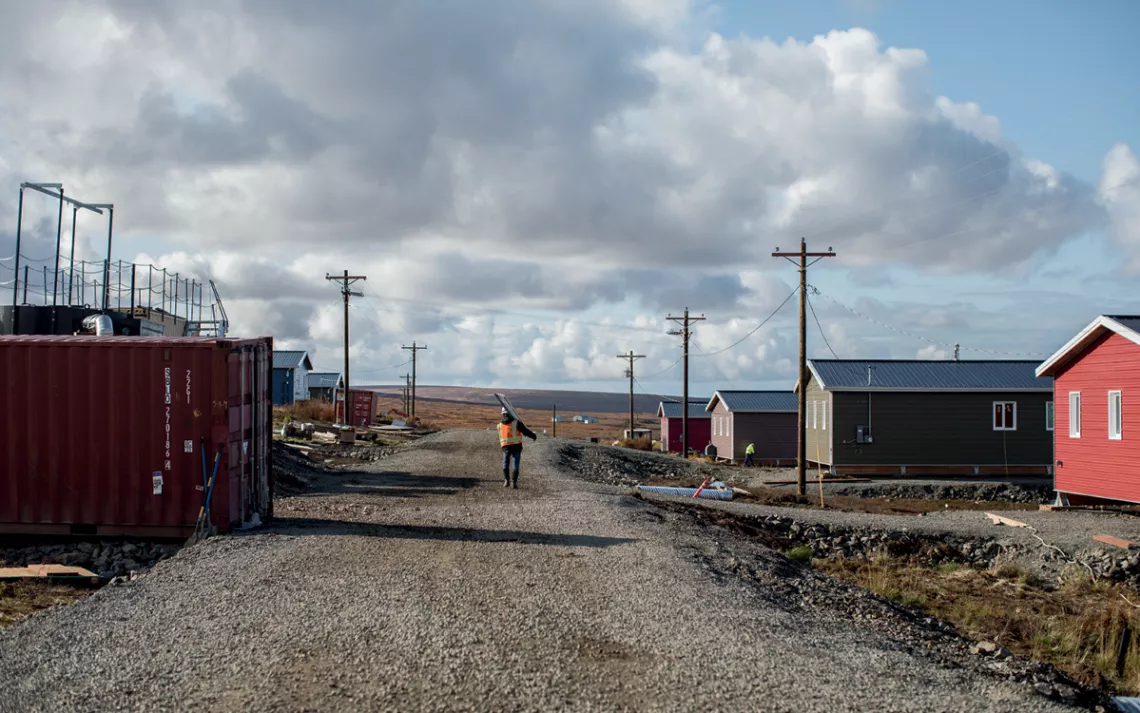
"That's our little village," he said, eyes glinting, a broad grin spreading across his face.
The boat landed. Onshore, the roads were dry and free of mud, even though it had rained the previous day. Here and there were the signs and sensations of a promising beginning—including clusters of wild-berry bushes and a meadow full of Labrador tea, smelling a little like citrus and cedar.
One house at the end of the row was brown, on a gravel pad, with a wide wooden porch overlooking the water. This was the new home of Charlene's parents. Inside, the structure was simple. The water tank perched demurely near the front door. The walls were about 12 inches thick, full of high-value insulation, the windows triple-paned to keep out the cold and the storms. It was clean and warm, full of light and fresh air. It would be space enough for three generations to sleep and eat and play in.
After touring the high-ceilinged, airy halls of the evacuation center, the group looped up the hill. Cadiente pointed out the utility poles, straight and sturdy and recently strung with
electrical wires. He paused in the road and turned his face toward the vista of houses and water.
"Stop," he insisted suddenly. "Isn't it pretty?"
FROM START TO FINISH, the relocation of Newtok will cost up to $150 million. With help from ANTHC, the community aims to build enough housing to allow the rest of the village to move by 2023. But in years to come, it may be impossible for every village to raise that amount of money from state, federal, or private sources. This is merely the first chapter in a much longer story about climate migration and the durability of Indigenous culture.
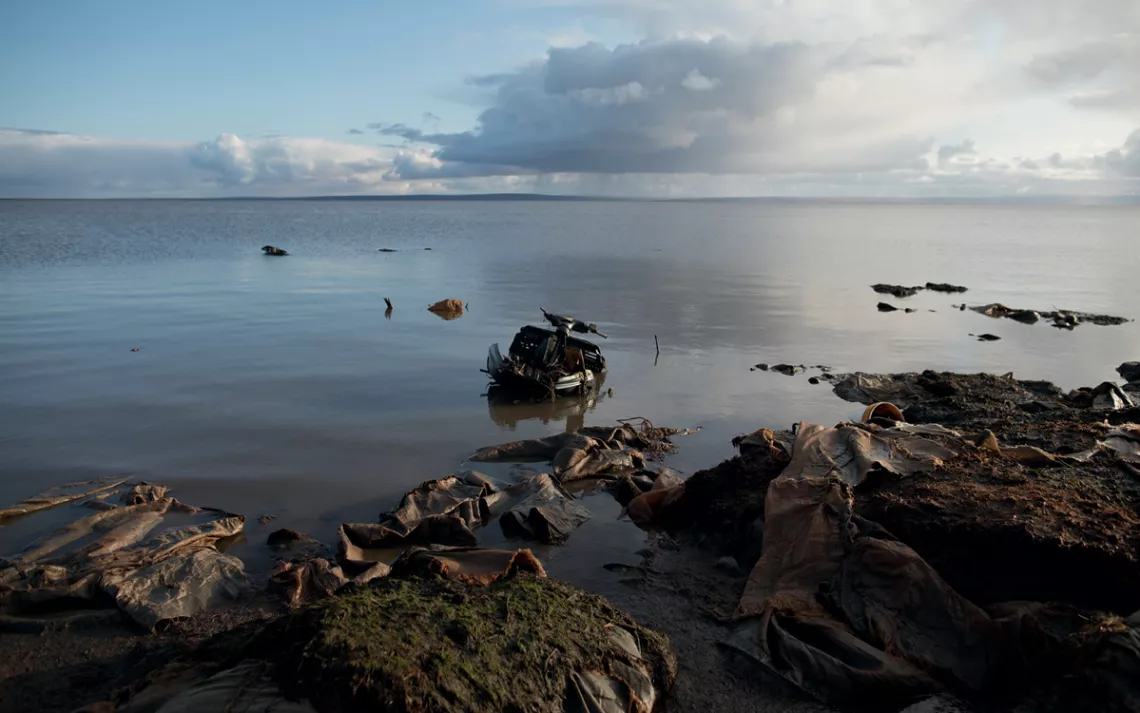
The land surrounding Newtok is littered with detritus from homes lost to erosion.
"At the end of our careers, we will have communities that successfully relocated," Cooke said. "I fully believe that Newtok is going to be successful. But there will be failures."
In mid-October, George and Lucy Carl, Charlene Carl, and Romy Cadiente boarded boats, crossed the river, and arrived in Mertarvik not as visitors but, for the first time, as residents. Charlene and Romy took a temporary bedroom in the evacuation center, close to the showers and the internet access—not home yet but better by far than a classroom floor. They all spoke of Mertarvik as if it were a set of brand-new shoes—well-made but not yet broken in. Cellphones worked only sporadically, and the store hadn't opened yet. George Carl complained that there was little to do in Mertarvik; the place was too quiet.
Cold weather set in, and the snow fell. Storms gathered day after day, but the houses at Mertarvik stayed warm and the land steady. In November, the Y-K Delta entered the season of freeze-up, when boats can no longer travel the waterways but the ice isn't yet thick enough for snow machines.
The two villages sat apart from each other, old and new, temporarily separated, waiting for the ice to bridge between them and for the year to end and another to begin, with its cycles of cold and thaw, hope and renewal.
This article appeared in the March/April 2020 edition with the headline "The Village at the Edge of the Anthropocene."
This article was funded by the Sierra Club's Beyond Coal campaign.
 The Magazine of The Sierra Club
The Magazine of The Sierra Club



